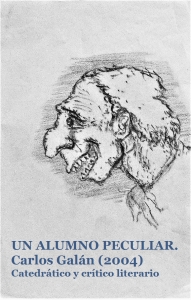A peculiar student. Carlos Galán (2004)
Text included in the book “El hacedor de sueños”, published on the occasion of the exhibitions in homage to Enrique Gran.
Caja Cantabria Cultural Centre, Santander, 2005.
Caja Cantabria Palace, Santillana del Mar, Cantabria, 2005.
Lebaniego Study Centre (Church of San Vicente), Potes, Cantabria, 2005.
 A PECULIAR STUDENT
A PECULIAR STUDENT
Enrique Gran had a rich and complex personality within a reserved and shy appearance that was undoubtedly transmitted to a strong, worked painting, made of vigorous brushstrokes, until achieving some shades that led us to suggested landscapes of extraordinary strength. Everything is far from syrupy and sweet concessions, some canvases that impress both by their beauty and by a sort of restless and perhaps tormented inner life, rich in nuances.
But Enrique Gran was much more than his canvases. He was a person overflowing with concern and eagerness to reach out to a culture that perhaps had been left somewhat out of his reach. I’ll bring back some personal memories that go back to the second half of the seventies and several academic summers. At that time, the programme of Spanish courses for foreigners at the Universidad Internacional Menéndez Pelayo included some theoretical classes on Spanish grammar.
They were very well received by the students, who were eager to discern the subtleties of our language without staying in the colloquial skin. The August classes were given by an eminent, and then very young, teacher, José Manuel Blecua Perdices. Author of a solid manual of Spanish Grammar and already a professor at the Autonomous University of Barcelona, he was a resounding success with foreign students. Today, after many years, he is an Academic of the Real Academia Española and, occasionally, curator of the celebrations organized in Spain on the occasion of the Centenary of Don Quixote.
To attend these classes, a curious character would come along: tall, strong, dressed in jeans and a jacket, also denim, both of good cut, clothes that attracted attention at the time, still not completely popular. He completed his attire with a kind of bag hung on a shoulder strap and in which he carried a book, a piece of fruit and perhaps a swimming costume, a lover as he was of the beach. Very respectful, enemy of transgressing rules, knowing that those teachings were destined to foreigners and not to natives, he always approached the Direction asking for a special permission to follow Professor Blecua’s classes, always from the discretion of the last rows. Anyone would have suspected that Enrique was looking for other, less confessable, objectives. That was a pretext for approaching foreign students and designing a summer romance, as so many other young people did at that time. But nothing could be further from his purposes. And it’s not that he didn’t like those European girls in the prime of life, whose eyes lit up well. But his intention was to learn something of our language and fill in the gaps that had been created for him over time. And he would ask questions at the end of the class and have interesting conversations with Professor Blecua and anyone else he could think of. Sometimes the discussion would continue in his studio, where he would take us and where we would discover his real world.
From the classes he would extend his time to lunch or dinner in the university canteen, with both teachers and students. For Enrique, that month of August was like experiencing a university atmosphere that he had lacked. And he fully enjoyed the two or three weeks that the grammar cycle lasted. No other teaching interests him, not even history, literature or art. But the Spanish language was his favourite class. And in living with the foreign students he had a glimpse of other cultures and customs. Later he stopped attending these classes, because Professor Blecua had also abandoned them. We would see him on the beach picking up seaweed that inspired him in original ways. We would cross our conversations by El Sardinero, slowly, amicably, remembering past times of which he kept a pleasant memory, although he never dared to return for classes that were not the same. Until we met again in his studio, in front of the sea, when he carried out the assignment that Eulalio Ferrer had given him, a Quixote of very personal realism, which would go on to swell the Cervantino Museum in Guanajuato, in Mexico. His work survives him and keeps his name alive in those lands, surrounded by other Quixotes and other Sanchos and some Dulcinea. Enrique stayed here, on this side, although for a short time unfortunately.
Very soon he made the jump to that other world from which he will contemplate, with smiling eyes and a touch of irony, everything that happens around here. Perhaps he will paint other pictures in which he will put the accent properly, as he learned from Professor Blecua.
Carlos Galán. Professor and literary critic
Santander, 7 December 2004
